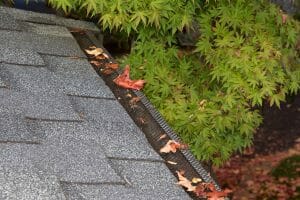
Gutter guards can sound like a miracle if you’re tired of digging wet leaves and roof granules out of your gutters twice a year or more often. However, you do need to choose the right gutter guards for your particular situation and still need to give these additions some maintenance. Having the right expectations for your new gutter guards will help you get the most out of them for years to come.
Tree Types Matter
The mature trees surrounding your home may offer shade and keep temperatures lower, but they also generate the majority of debris that ends up in your gutters. This doesn’t change just because you’ve put in gutter guards. While the right gutter guard will keep the majority of debris out of your gutters and reduce cleaning dramatically, there is still a chance of small debris getting in no matter what. Small pine needles in particular or very small leaves will likely still get into the gutter through the guard. If nothing else, these materials are likely to accumulate on top and may need occasional cleaning. Large-leaved trees work well with gutter guards because this foliage is unlikely to end up getting through the material.
Cleaning the Guards is Still Required
While you can greatly reduce the amount of cleaning your gutters will need for years to come, there is still some occasional cleaning needed to keep material from gathering on top of the guards. The amount of maintenance needed for keeping gutter guards clean is far less than you’d need to do for uncovered gutters. If you do let enough debris build up, the guards can’t do their job and allow water to flow through properly into the downspout. Pairing the right guards to your gutter based on the type of debris you experience the most will result in the least amount of maintenance. It also tends to be easier to clean gutter guards from the ground than entire gutters, reducing the need to climb ladders.
Safer Winter Roof Edges
You can protect your roof edges during the winter and reduce safety hazards by using gutter guards. These guards allow water to flow away so that icicles don’t form. Icicles can fall on you and cause an injury, so reducing the build up of this ice is a good idea. By keeping water flowing smoothly away from the edges of the roof, you’ll also reduce the chances of ice damming. This occurs when water freezes on the roof edges and then causes snow to melt behind it, allowing water to soak through the roof. Keep your gutters working even in the winter with durable gutter guards.
Guards are Easily Removable
Since there is occasionally the need to clean inside the gutters even with guards, you’ll want to be able to remove them quickly for maintenance. The best gutter guards will attach with clips or a tension design that makes them easy to pop out whenever you need to access the gutters. Set the guards on the roof, complete your clean-up, and replace them in just a few minutes.
Easier to Gather Rainwater
Keeping your gutters flowing smoothly and staying clean of debris results in cleaner, more useful rainwater. Gathering rainwater is a great practice to help provide a steady supply of water for your lawn, gardens, or trees without violating drought restrictions. Gutter guards keep debris out of the gutters, reducing how much organic material breaks down and ends up mixed up with the rainwater. This means the water will store longer without getting discolored or off-smelling, allowing you to keep hundreds of gallons for months if necessary.
Plenty of Color Matching Options
There’s no need to have gutter guards that stand out and clash with the rest of your home’s exterior. You can find gutter guards in all colors and finishes to help create a seamless look. In fact, adding guards can actually help the gutters blend in with the exterior rather than standing out on their own. If you want a contrasting edge along your roof, consider a gutter guard with a different color. A dark gutter guard on a light gutter can draw the eye and make the home look more dramatic. Don’t just consider the functional value of a gutter guard when it can improve the aesthetics as well.
Choosing the Right Type of Gutter Guard
With five different types of gutter guards available on the market today, you have to match the right material to your specific installation. This is best done by a professional who can take into consideration the average amount of rain you receive, the downspouts you have and their placement, the debris that most commonly clogs your gutters, and your goals for the rainwater. You may need a fine mesh guard to deal with small debris, or a simple foam design to keep leaves and pine needles under control. Letting a professional choose the gutter guards will result in a better fit and longer-lasting debris control with reduced maintenance for the lifespan of the upgrade. There’s also no need to struggle with DIY installation either.
Upgrading the Downspout
Don’t just think of upgrading your gutters by covering them with guards. Consider your entire roof drainage system, including your downspouts that carry the water away. Placing a set of screens or filters in the downspout where you can access them will also help with cleaning them out and preventing clogs that could back water up into the gutters even with guards. By using downspout debris traps and gutter guards together, you’ll deal with far fewer problems with drainage around your home at all times.
Choose Kguard to protect your home with gutter guards you can rely on. Reach out to us for custom recommendations on how to cap off your gutters and keep them clean all year round. We can address the entire gutter system, including the downspouts.
This post first appeared on https://www.kguard.com